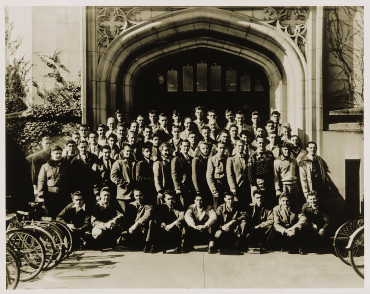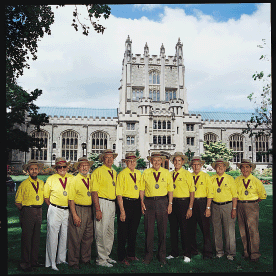Vassar's Vets: Forgotten Grads
The millions of former servicemen who sought to attend college with GI Bill® support overwhelmed the capacity of the colleges and universities that would accept men. Womens colleges, including Vassar, were asked to help.
Fifty-four years ago Vassar College accepted its first male students. This may come as a surprise in this year in which 30 years of coeducation were celebrated at Vassar.But the fact is, Vassar had male students even before it became officially coed, and from 1948 to 1953, 16 of those men earned bachelor's degrees at the college.
The men were veterans of World War II who entered Vassar under the GI Bill®. Thirty-six of them entered Vassar in April of 1946. That fall, their numbers almost tripled. Altogether, according to information from the registrar's office, 170 male veterans took classes at Vassar in the post-war years. Most left Vassar before graduating, either transferring to another institution or for employment. Those who stayed to earn bachelors degrees were awarded them by the the State University of New York, not Vassar, whose charter prevented the college from awarding degrees to men. Since most of the veterans entered with the class of '50, they have, over the years, been affiliated with that class. (Half of the veterans who graduated via Vassar did so in 1950.)

Vassar's veterans in 1947
Serious, dedicated, determined, and experienced beyond their years, these former soldiers were the first Vassar men. This past June, they joined 1950 in celebrating their 50th reunion, and, some of them say, the 50th anniversary of coeducation at Vassar.
The Vassar veterans were only a few of the millions of former soldiers who were beginning or continuing their college educations courtesy of Public Law 346-the GI Bill® of Rights, signed into law by President Franklin Delano Roosevelt in 1944. The popular and widely supported legislation allowed two million Americans returning from the various corners of the war-torn world to attend college.
According to Peter Berg '50, who wrote in the March 1947 Vassar Alumnae Magazine, Vassar's fall 1946 entering class of veterans comprised men whose "former ranks in the service ranged from private to major, with all branches represented." The average age of the men was 21, and their average length of service was three-and-a-half to four years, Berg reported. Thirteen of them were married. Before the war, 22 had attended colleges such as Cornell, Princeton, Yale, the University of Rome, the University of Vienna, and the GI University at Biarritz. They studied, "in order of popularity: English, mathematics, physics, chemistry, economics, psychology," Berg wrote. Many of them planned to continue on to pre-med or pre-engineering programs as soon as room could be found for them.
(The first class of veterans attending Vassar on the GI Bill® also included two women: Margaret Stevenson '48 left Vassar the summer after her sophomore year [1944] to enlist in the United States Naval Reserve's Women Accepted for Volunteer Emergency Service [WAVES]. She returned to Vassar in the spring of 1946, this time on the GI Bill®, after serving two years in the WAVES. No record of the identity of the other woman veteran, who reportedly served in the Women's Army Corps [WAC], could be located).
How did these men end up at one of the most prestigious American institutions for women? Essentially, it was a case of necessity. In 1946, more than one million veterans enrolled in colleges nationwide. The number, reports Michael J. Bennett in When Dreams Came True: The GI Bill® and the Making of Modern America (Brassey's, 1996), was almost twice what authorities had expected.

The veterans returned to Vassar in June 2000 for a 50th reunion.
"All across the country," wrote Michael D. Haydock in the October 1999 American History, "colleges scrambled to meet the needs of the returning veterans. Lack of classroom space, teacher shortages, and inadequate housing for the students all became immediate problems."
The situation was no different in New York, which lacked a state university system until 1948, when the influx of veteran enrollees prompted the state legislature to create one. So, early in 1946 Governor Thomas E. Dewey requested that the state's women's colleges open their doors to the veterans. Vassar, ever the socially conscious institution, did so.
"We were all so thrilled that the war was over and delighted with the GI Bill®; concept," said Ebba Jo Tate Spettel '50, class reunion chair, in an interview last May. "We thought it was very natural for Vassar to open its doors to the veterans."
An editorial in the March 27, 1946, Miscellany News elaborated on the positive aspects of having the veterans on campus. The former soldiers who had seen so much of the world would add to the scope of academic discussions, wrote the editors. And the fact that most of them were from Poughkeepsie would help bolster town-gown relations. But most important, aiding the veterans in their return to civilian lives would be an extension of patriotic duty.
"During the war," the editors wrote, "we have cooperated with the government in its effort to prosecute the fight against the submergence of democracy and the liberal tradition. . . . The peace is giving us our chance to make a contribution to the reconstruction and fortification of the values for which we fought."
High principles and patriotism aside, however, the physical presence of the veterans on campus was an exciting yet challenging adjustment for both the men and the women. The women worked to help the veterans feel accepted in the community, to continue on with their own studies despite the media attention the veterans seemed to attract, and to figure out how to live with men in a world so carefully constructed just for women. The men struggled to feel accepted by an administration many of them saw as unwelcoming, to regain or gain the intellectual dexterity that the faculty demanded, and to be men in a woman's world.
"I was awed by the whole thing," said Poughkeepsie resident Forrest Cousens '50 in a recent interview. "I wasn't sure what to expect or how hard it was going to be." But it wasn't long before Cousens and the rest of the veterans felt at home on Vassar's campus, thanks to the determination of the faculty and the students. "In less than two months that the majority of the veterans have been attending Vassar College, they have proceeded with an achievement of assimilation that is remarkable," wrote veteran Jack Schwarzschild '50 in his Vassar Chronicle column on October 26, 1946.
They organized a Veteran's Association, complete with officers and weekly meetings; took part in plays; wrote for the Vassar Chronicle and the Miscellany News; played basketball on a team that they created (the men had been invited to play football by the veterans at Skidmore College, but President Sarah Gibson Blanding prohibited the creation of a football team at Vassar because the college had no facilities or coaching for football); organized social events such as the Hangover Ball and a Christmas party for the Poughkeepsie children who had lost fathers in the war; and pinch-hit over Christmas vacation for the women students who volunteered at local schools.
When they wanted a respite from the women, the men gathered in a room in Main building given over to them as a place to study and hold their association meetings. They had "changed themselves from a group of outsiders to an integrated part of the college campus," wrote Schwarzchild.
Still, the picture was not completely rosy. Just a few months later, on April 5, 1947, Schwarzschild wrote: "When they were first accepted by Vassar, [the veterans] felt that they had been admitted into one of the top-ranking American colleges. Since then, many of them discovered that they had never really been accepted for anything but attendance at classes. In these classes they ran into difficulties at times. Their classmates had last year's notes, a roommate majoring in the course, a much more thorough and recent educational background, and the kind of quiet, well-regulated life vital to scholarship, whereas most of the men lived off-campus, ate off-campus and thought off-campus. With hardly any exceptions they did their utmost to transfer to another college, where they might at least be able to work towards a degree. Even that privilege was denied to many of them."
In particular the veterans recall feeling alienated by the administration, which was bound by a college charter that denied men the privilege of a Vassar degree. The men felt that they heard "no" from the administration more than they heard "yes," and they found it very discouraging. "We were such a minority," said Carmine Calenti '50 recently. "We often felt like stepchildren."
But, said Elizabeth Adams Daniels '41, Vassar historian and professor emeritus of English, it was a situation that could not be helped. "The college was a substitute home for the [women] students, so the social regulations were very strict. The rules were not made for the men. I don't think that the administration was hostile to them. The rules were just not applicable."
However, life for the Vassar veterans was apparently better than at some other women's institutions. On January 11, 1947, Schwarzschild reported in his column that two veterans, Ed Clark '50 and Bill Werner '50, had attended a conference of veterans attending women's colleges such as Sarah Lawrence, Smith, and Russell Sage. "They discussed the many problems arising from their unusual situation, perhaps trying to determine just what a man's place is in a woman's college. . . ," wrote Schwarzschild.
"Summarizing the conference," he continued, "Bill Werner expressed his belief that 'the men at Vassar are in an exceptionally favorable position since they are students at one of the few women's colleges which is giving equal attention and privileges to its men.' "
In 1972, after Vassar officially became a fully coeducational college, Vassar conferred its degree on 11 of its earliest male graduates (the remaining were either lost to the college or deceased). This year, 10 of the veterans who attended Vassar returned with that class to celebrate a 50th reunion. It was a bittersweet moment for them: Said Forrest Cousens, who organized the veterans' reunion, "I never had any reason to come back to Vassar. They just forgot about me and anyone else." A heart attack in 1988 motivated him to search out and reconnect with old friends from his college days. And so, on June 3, 2000, Cousens and nine of his veteran peers stood for a group photo in front of the Vassar Library, much as they had done 54 years earlier. This time, their feelings were different. As Carmine Calenti reported beforehand, "I feel more like I belong, like this is my school."
Jessica Winum is assistant editor of the Vassar Alumnae/i Quarterly.
